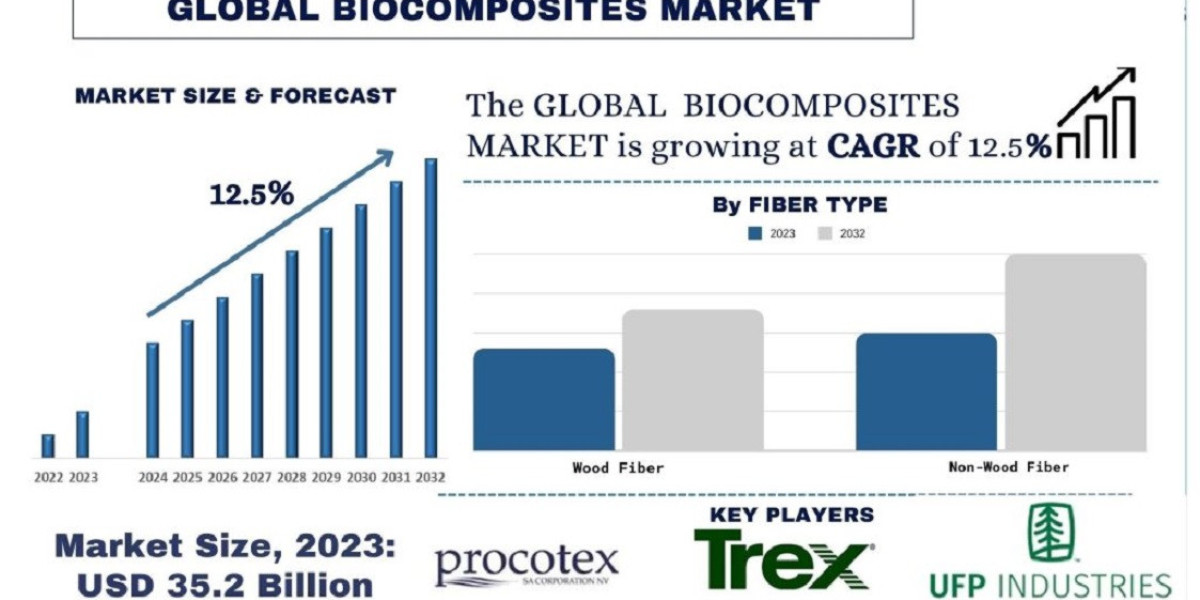Biocomposites: An Overview
Biocomposites are composite materials made from natural fibers and a polymer matrix, which can be derived from renewable sources or traditional plastics. The natural fibers, such as wood, flax, hemp, and jute, provide reinforcement, while the polymer matrix, which can be either biodegradable (like polylactic acid, PLA) or synthetic (like polypropylene, PP), binds the fibers together and facilitates load transfer. They offer an eco-friendly alternative to conventional composites and plastics by utilizing sustainable resources and reducing environmental impact.
According to the UnivDatos Market Insights analysis, the rising prevalence of sustainable products will drive the global scenario of the Biocomposites market. As per their “Biocomposites Market” report, the global market was valued at USD 30.5 Billion in 2023, growing at a CAGR of 12.5% during the forecast period from 2024 - 2032 to reach USD 90.3 Billion by 2032.
For More Detailed Analysis in PDF Format, Visit- https://univdatos.com/get-a-free-sample-form-php/?product_id=60483
compared to traditional materials like plastics and metals. Their production typically involves less energy-intensive processes and results in lower greenhouse gas emissions. Biocomposites often have lower levels of toxicity and are safer for both consumers and manufacturers. Unlike many traditional composites, they do not release harmful emissions during production or disposal, contributing to a healthier environment. Asia-Pacific is rapidly emerging as a significant market, driven by expanding manufacturing sectors, particularly in China and India, and increasing environmental concerns.
While the initial costs of biocomposite materials can be higher than conventional materials due to the nascent stage of technology and smaller scale of production, advancements in processing and economies of scale have the potential to reduce these costs over time. The future of the biocomposite market looks promising with continued technological advancements and growing environmental awareness. As production processes become more efficient and economies of scale are achieved, biocomposites are expected to become more cost-effective and widely used, paving the way for a sustainable future in material science.
Biocomposites Overview in APAC
The Asia-Pacific (APAC) biocomposite market is characterized by rapid growth and diverse applications, driven by the region's vast agricultural resources and expanding industrial base. Countries like China, India, Japan, and South Korea are leading in producing and utilizing biocomposites, leveraging them primarily in the automotive, construction, and packaging industries. The market benefits from abundant natural fiber resources, such as bamboo, jute, and sisal, and a strong manufacturing sector. Additionally, increasing environmental awareness and governmental policies to reduce plastic use and promote sustainable materials significantly fuel market growth.
The growth of biocomposites in APAC offers substantial environmental benefits by reducing reliance on fossil-based materials and enhancing the sustainability of industrial processes. Economically, the market contributes to the diversification of industrial outputs and promotes innovation in material sciences, potentially leading to job creation and economic development in rural areas where natural fibers are sourced. However, the biocomposite market faces challenges, such as technological advancements to improve material properties and the scalability of production processes to meet the increasing demand.
A focus on research and development is essential for the APAC biocomposite market to continue its growth trajectory. This includes improving the durability and performance of biocomposite materials to broaden their applications in more demanding industries. Additionally, regional governments can enhance the market's potential through incentives for using sustainable materials and stricter regulations on non-renewable plastics. Strengthening the collaboration between research institutions, industries, and governments will also be critical for driving innovation and adoption.
China is the biggest consumer and one of the major manufacturing hubs for Biocomposites
China’s biocomposite market is rapidly expanding, fueled by the country's extensive industrial base and strong governmental support for sustainable development initiatives. As one of the largest manufacturers and consumers of biocomposites in the Asia-Pacific region, China integrates these materials primarily in the automotive, construction, and packaging industries. The country's vast agricultural resources provide abundant natural fibers such as bamboo, which is extensively used due to its rapid growth rate and mechanical strength. Additionally, China’s commitment to reducing its environmental footprint and enhancing material efficiency has led to significant investments in biocomposite research and development, positioning the country as a leader in this field. For instance, China announced in February 2024 a new five-year plan focusing on biocomposite development as part of its broader initiative to decrease pollution and increase the use of renewable resources in industrial applications.
Developing the biocomposite market in China carries significant environmental and economic implications. Environmentally, the shift towards biocomposites helps reduce reliance on non-renewable polymers, decreases carbon emissions, and promotes waste reduction through biodegradable materials. Economically, the biocomposite sector supports China’s manufacturing industry, drives innovation, and has the potential to create a substantial number of jobs, particularly in rural areas where natural fibers are harvested and processed. However, challenges such as scaling production to meet global demand, ensuring product quality and consistency, and reducing costs remain.
The future growth of China’s biocomposite market will depend on continued innovation and government support. Increasing investment in research to improve the quality and reduce the costs of biocomposites is crucial. Additionally, fostering public-private partnerships can accelerate the commercialization of new biocomposite technologies. Expanding the application areas of biocomposites into more high-value markets, such as electronics and aerospace, could also provide new growth opportunities. Moreover, implementing stricter environmental regulations and incentivizing companies to adopt sustainable practices will further boost the biocomposite market.
Explore the Comprehensive Research Overview - https://univdatos.com/report/biocomposites-market
Conclusion
The biocomposites market in China and the broader Asia-Pacific (APAC) region is poised for rapid expansion, fueled by increasing environmental consciousness, robust government policies, and significant industrial advancements. China, in particular, is emerging as a key player in the biocomposites market, driven by stringent environmental regulations, substantial investment in renewable resources, and a growing emphasis on sustainable development. Government initiatives such as China's Five-Year Plans consistently emphasize green growth and adopting eco-friendly materials, creating a favorable environment for biocomposites. Countries like India, Japan, and South Korea are also making significant strides in the wider APAC region. India's National Policy on Biofuels and various state-level initiatives promote using bio-based products, including biocomposites, to enhance energy security and reduce environmental impact. Japan's Biomass Nippon Strategy and South Korea's Renewable Energy Act provide subsidies and research grants to foster the development and utilization of biocomposites. These policies reflect a strong regional commitment to sustainability and innovation in material sciences. The market dynamics in APAC are further supported by the region's vast agricultural resources, which provide an abundant supply of natural fibers essential for biocomposite production. The region's manufacturing prowess and cost-competitive labor market make it an attractive hub for biocomposite production and innovation. The growing consumer preference for sustainable products and the corporate sector's increasing focus on green initiatives further bolster the market demand.
In conclusion, the biocomposites market in China and the APAC region is set for significant growth, underpinned by supportive government policies, resource availability, and technological advancements. As environmental sustainability becomes a central focus, adopting biocomposites in various industries is expected to accelerate, positioning China and APAC as pivotal regions in the global biocomposites landscape.
Contact Us:
UnivDatos Market Insights
Email - contact@univdatos.com
Website - https://univdatos.com/








